

The above image represents Humankind's return to the Red Planet.
More than twenty years after the Viking I and II missions, Pathfinder has
landed on Mars.
The image above was one of the first to be downloaded.
Note the hill rising on the far top-right.
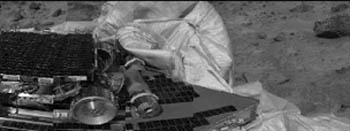
From ABCNEWS.com:
The first images from Pathfinder showed a lander and rover in ship shape on
the Martian surface, with just one small problem.
The airbags that cushioned the lander's impact with Mars didn't fully
retract. They initially blocked the path the rover would use to drive off
Pathfinder and onto the Martian surface. Rover team scientists were
unconcerned, however. They had planned for this eventuality and had a
simple fix at the ready.
By lifting the "petal" slightly, they can use the lander's winches to
further withdraw the airbags, and pull them out of the way.
The spacecraft's main, and most powerful antenna was locked onto by Mission
Control at 7:30 P.M. EDT. It's transmitting the first images from the
surface of Mars in over two decades.
Pathfinder called home about 5:20 P.M. EDT to tell NASA the landing went
perfectly. After touching down this morning, Pathfinder withdrew its
airbags and deployed its petals, then waited for the Sun to rise over Ares
Vallis, the landing site. The initial return of data indicated everything
went as planned.
The temperature on the surface of Mars where the lander sits was about minus
64 degrees Fahrenheit and the gravity roughly one-third that of Earth.
Though its situation seems relatively cushy now, Pathfinder experienced
some pretty powerful forces as it landed. On its first bounce alone it
withstood a shock 18.6 times the power of Earth's gravity.
Pathfinder had no difficulty unlocking its sensor "head" which is critical
to locating the Sun. The lander uses the Sun to aim the high-gain antenna
toward receivers on Earth. Those signals, which carry about as much
information as a modem from the early '80s, take about 11 minutes to travel
to Earth.
At about 5:21 P.M. EDT Pathfinder began transmitting detailed information
about the status of the lander and rover. NASA released Pathfinder's first
images at about 7:30 P.M. EDT, after the Sun rose on Mars.
It took about an hour to retract the giant airbags that cushioned
Pathfinder's landing. Once deflated, the craft's three petals opened up;
these stabilized the lander and capture the Sun's rays to generate power.
Later in the day, the real star of the show makes its appearance. The
Sojourner rover, which according to Mission Control "is awake and healthy,"
will venture out of Pathfinder and start wandering about.
The goal of NASA's beagle-sized Martian dune buggy is to survey the Martian
surface, and gather information about the rocks on Ares Vallis, the flat
Martian flood plain where Pathfinder rests.
Sojourner is no Energizer Bunny; it will stay outside the lander only as
long as its non-rechargeable lithium batteries hold out, anywhere from a
week to a month.
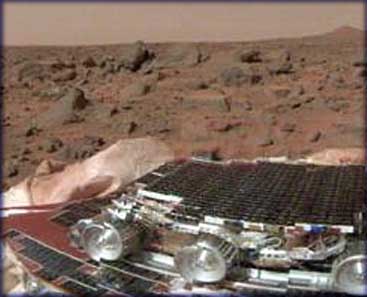
The image below shows that now the Mars Pathfinder airbags have been
successfully retracted, allowing safe deployment of the rover ramps.
The airbags visible prominently in the first images are noticeably retracted at
the bottom of this image. The Sojourner rover is seen still docked, and
rocks are visible in the background.

The image below is a mosaic, prepared by Andrés Valencia, showing a
panoramic of the South view of the Carl Sagan Memorial Station on Mars.
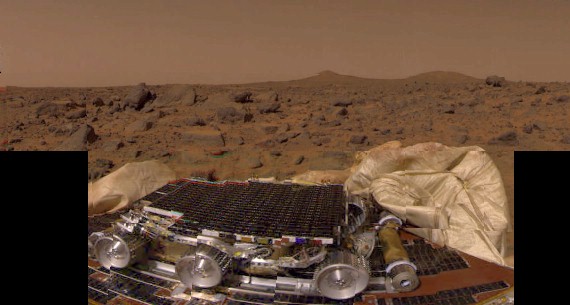
The mosaic was built from NASA-JPL images 80808_full.jpg, 80811_full.jpg, 80812_full.jpg, and 80815_full.jpg.
80808_full.jpg (left):
Large boulders are visible in this enlargement of pictures taken by the Mars
Pathfinder lander camera on July 4, 1997. The landing site is in the dry
flood channel named Ares Vallis. The boulders probably represent deposits
from one of the catastrophic floods that carved the ancient channel.
Between the rocks is brownish windblown soil. The gray-tan sky results from
dust particles in the atmosphere.
80811_full.jpg (center):
This is one of the first pictures taken by the camera on the Sagan Station
shortly after its touchdown at 10:07 AM PDT on July 4, 1997. The small
rover, named Sojourner, is seen in the foreground in its position on a
solar panel of the lander. The white material on either side of the rover
is part of the deflated airbag system used to absorb the shock of the
landing. Between the rover and the horizon is the rock-strewn martian
surface. Two hills are seen in the right distance, profiled against the
light brown sky.
80812_full.jpg (right):
In this image from the Pathfinder IMP camera, a diversity of rocks are
strewn in the foreground. A hill is visible in the distance (the notch
within the hill is an image artifact). Airbags are seen at the lower right.
80815_full.jpg (bottom):
This image from the Mars Pathfinder IMP camera shows airbags in the
foreground, a large rock in the mid-field, and a hill in the background.
Visible at the rear end (right) of the rover is the Alpha Proton X-Ray
Spectrometer.
The Sojourner rover and undeployed ramps onboard the Mars Pathfinder
spacecraft can be seen in this image, by the Imager for Mars Pathfinder
(IMP).
The microrover Sojourner is latched to the petal, and has not yet been
deployed.
The ramps are a pair of deployable metal reels which will provide a track
for the rover as it slowly rolls off the lander, over the spacecraft's
deflated airbags, and onto the surface of Mars.
One or both of the ramps will be unfurled, and then scientists will decide
whether the rover will use either the forward or backward ramp for its
descent.
The airbags behind the rover were at this time blocking the ramp from being
safely unfurled.
The rover is 65 cm (26 inches) long by 18 cm (7 inches) tall; each of its
wheels is about 13 cm (5 inches) high.
A number of image processing artifacts are seen in this picture. Most
apparent are seams between sub-frames offsetting portions of the rover's
wheels and solar panel, color fringes that result from viewing the rover
from the two separated eyes of the camera, and blocky fringes near edges
and smooth areas that are created by data compression.

This is an image link to a reduction (64KB) of the 360 degree, high resolution 'Presidential Panorama' taken by the Mars Pathfinder lander IMP camera on Sols 17 and 18 (July 21, 1997).
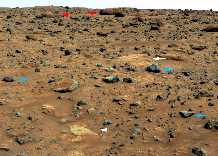
This image is a link to a view (56KB) to the northeast of the lander, it is annotated to show the variety of rocks in this landing site and what they tell us.

This portion of the "monster panorama" shows some of the unofficial names
that have been applied to rocks at the Pathfinder landing site.
Barnacle Bill, Yogi, Scooby Doo, and Lamb have been investigated by the
Sojourner rover and its Alpha Proton X-Ray Spectrometer. Couch is a large
rock on the horizon.
The names are used by the Pathfinder team to help identify and keep track
of the many rocks at the landing site.
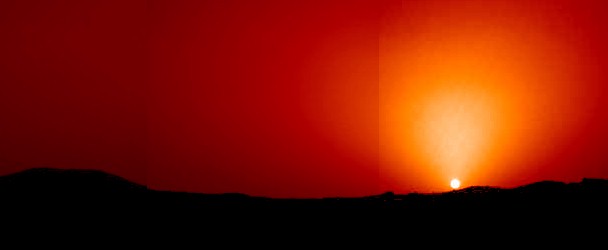
Mars Sunset on Sol 28-29 (1-2 August 1997).
Link to the Pathfinder Mission Rover in ARVAL
Link to the Pathfinder Mission 3-D Images
in ARVAL
(Requires red and blue filters)
Link to the Pathfinder Mission Status Reports
in ARVAL
(Segmented in weeks, updated daily)
Updated: August 5 '97
Best seen with MS Internet Explorer.
Back to the Mars Pathfinder Page in ARVAL
Messages: